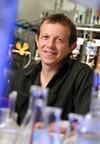Research Terms
Bioprocessing Engineering Chemical Engineering Pollution Control Cleanup Technology Emission Control Water Pollution Plasma
Keywords
Famu-Fsu College Of Engineering Non Thermal Plasma Reactor Design
Industries
Air & Environment Water Biotech
Professor Bruce R. Locke earned his B.E. in Chemical Engineering and Environmental and Water Resources from Vanderbilt University in 1980, M.S. degree from University of Houston in 1982, and his Ph.D. in Chemical Engineering from North Carolina State University in 1989. From 1982 to 1986 he was a research engineer at the Research Triangle Institute, Research Triangle Park, NC, where he worked on measurement and analysis of aerosol particles in microelectronics manufacturing. He has been a faculty member in the Department of Chemical and Biomedical Engineering at the FAMU-FSU College of Engineering since 1989 where he also served as Department Chair from 2004 until 2012. He was an Associate Provost at Florida State University (FSU) from 2012 to 2018 during which time he also served as interim dean of the FAMU-FSU College of Engineering from 2015-2016. Since 2019 he is again serving as Department Chair of Chemical and Biomedical Engineering. He was named an FSU Distinguished University Research Professor in 2010. Dr. Locke has published over 140 peer reviewed journal papers and 8 book chapters with over 14,000 citations. He holds 11 US patents of which 4 are currently under license for commercialization. He was a visiting professor in Japan, France, and China, and was a US Fulbright Research Scholar at the Institute of Plasma Physics, Czech Academy of Sciences, Prague in 2017-2018. He is a Fellow of the American Institute of Chemical Engineers, co-Editor-in-Chief of Plasma Chemistry and Plasma Processing and serves on the Advisory Board for Plasma Processes and Polymers. His research interests include plasma reaction engineering for chemical synthesis and environmental pollution control, with particular emphasis on gas-liquid plasma reactor design and development.
IEEE, Member; 1999 - present
American Chemical Society, Member; 1989 - present
American Institute of Chemical Engineers, Member; 1982 - present
Plasma Chemistry and Plasma Processing, co-Editor in Chief, Springer; 2009 - 2022
Plasma Processes and Polymers, International Advisory Board, Wiley VCH; 2008 - 2022
Professor Bruce R. Locke earned his B.E. in Chemical Engineering and Environmental and Water Resources from Vanderbilt University in 1980, M.S. degree from University of Houston in 1982, and his Ph.D. in Chemical Engineering from North Carolina State University in 1989. From 1982 to 1986 he was a research engineer at the Research Triangle Institute, Research Triangle Park, NC, where he worked on measurement and analysis of aerosol particles in microelectronics manufacturing. He has been a faculty member in the Department of Chemical and Biomedical Engineering at the FAMU-FSU College of Engineering since 1989 where he also served as Department Chair from 2004 until 2012. He was an Associate Provost at Florida State University (FSU) from 2012 to 2018 during which time he also served as interim dean of the FAMU-FSU College of Engineering from 2015-2016. Since 2019 he is again serving as Department Chair of Chemical and Biomedical Engineering. He was named an FSU Distinguished University Research Professor in 2010. Dr. Locke has published over 140 peer reviewed journal papers and 8 book chapters with over 14,000 citations. He holds 11 US patents of which 4 are currently under license for commercialization. He was a visiting professor in Japan, France, and China, and was a US Fulbright Research Scholar at the Institute of Plasma Physics, Czech Academy of Sciences, Prague in 2017-2018. He is a Fellow of the American Institute of Chemical Engineers, co-Editor-in-Chief of Plasma Chemistry and Plasma Processing and serves on the Advisory Board for Plasma Processes and Polymers. His research interests include plasma reaction engineering for chemical synthesis and environmental pollution control, with particular emphasis on gas-liquid plasma reactor design and development.
Annually, approximately 810 M barrels of oil (equivalent) are used globally as feed-stock to produce 147 M metric tons of synthetic nitrogen-based fertilizer which is vital for producing the food supply to sustain the world’s population. The production of this fertilizer is not only energy intensive, but also leads to significant environmental pollution and affects the economic viability of farming in many parts of the world. In this work, an FSU patented flowing film plasma reactor is utilized to generate nitrogen fertilizer in an environmentally friendly way using only air, water, and electricity. The environmentally friendly fungicide and bactericide, hydrogen peroxide, is also simultaneously produced. This process can provide these compounds continuously and on-demand as “green” nitrogen fertilizer and as a “green” fungicide/bactericide, enabling farmers to produce fertilizer on-site as needed and reduce the need to use harmful pesticides. Our system can produce locally the required concentrations of nitrate and hydrogen peroxide, thereby removing the need for shipping and storing large quantities of highly concentrated, hazardous, and potentially dangerous chemicals. The basic physics and chemistry of nitrate generation with plasma discharge is well known from naturally occurring lightning in thunderstorms. This work aims to develop a deeper understanding of how this reactive chemistry can be replicated and harnessed. Aspects of both the power supply and reactor configuration are investigated to increase both the energy yield and production rate of the process. The technology is currently under license to Redhill Scientific, LLC, a startup company specializing in commercializing plasma technology from Professor Locke’s laboratory.
Subject Areas:
Audience:
Adults
Duration:
1 hour or less
Fee:
Expenses Only


An increasing number of types and vast amounts of different complex organic compounds into the natural environment. Of these compounds, the emerging contaminants, those typically not regulated or routinely monitored by government agencies, include a wide range of pharmaceuticals and personal care products (PPCPs), and other compounds that cannot be degraded or removed in conventional drinking water and wastewater treatment processes. Many of these compounds can have adverse effects on the environment, animal, and human health (e.g., endocrine disruption), even at low concentrations. For example, widespread release of antibiotics has led to the evolution of antibiotic resistant bacteria which reduce our capability to manage infectious diseases. Such compounds are released into drinking water, ground water, and wastewater from hospitals, water treatment plants, and distributed sources such as septic field and edge agricultural runoff. Many of these compounds are not readily biodegradable, some are highly persistent in the environment, some may accumulate in the food chain, and some may degrade into more hazardous compounds causing further environmental and health issues. Approximately 700 emerging pollutants, including their metabolic and degradation products, are listed in Europe.
Biological reactors offer significant energy efficiency, but require significant residence times, on the order of days or weeks, in order to fully degrade some contaminants. Also, biological reactors are incapable of degrading some toxic organic compounds, or are incapable of completely degrading some organic contaminants to mineralized products. Plasma reactors that only treat liquid contaminants combined with biological reactors are incapable of degrading gas phase contaminants. Such combined systems also are not readily adaptable to changing contaminant composition streams.
In order to solve these issues, this novel technology uses a mixture comprising liquid water, a gas and organic compounds, which are injected into a non-thermal gas-liquid plasma discharge reactor to generate a flowing liquid film region with a gas stream flowing alongside. A plasma discharge is propagated along the flowing liquid film region. During this process, water is
dissociated and reactive species such as hydroxyl radicals, hydrogen peroxide, and nitrogen oxides are formed. The organic compound reacts with the reactive species such as hydroxyl radicals and hydrogen peroxide present in the flowing liquid film region and in the flowing gas stream to produce organic compound dissociation products. Some of the organic compound dissociation products and nitrogen oxides are transferred to a bioreactor for further degradation. The nitrogen oxides are used as nutrients for bacteria in the bioreactor. The combination of the two reactors saves energy and time on the process of degrading the compounds, thereby cutting costs. Additionally, the increased efficiency of the system is far greater than the addition of the two individual reactors.
Electrical discharge plasma contacting liquid phases has been studied for a wide range of chemical, biomedical, environmental, and Materials synthesis applications. The present invention utilizes a gas-water-organic plasma reactor for the conversion of alkanes into functionalized products (alcohols, aldehydes, etc.) using a pulsed plasma reactor with liquid water and flowing carrier gas. Hydrogen peroxide is also generated conjunction with the functionalized products.































2525 Pottsdamer Street TALLAHASSEE, FL

